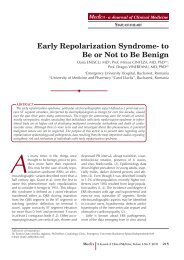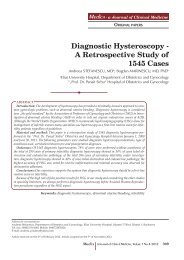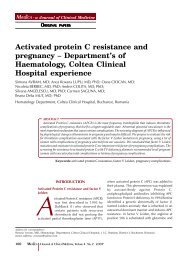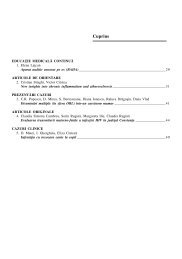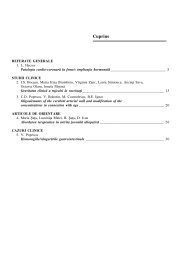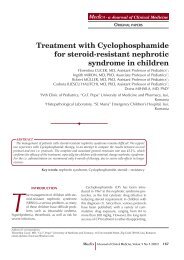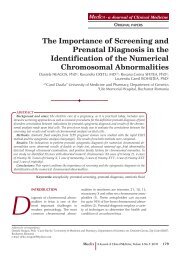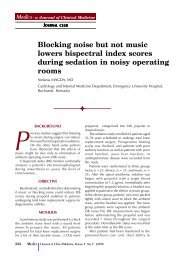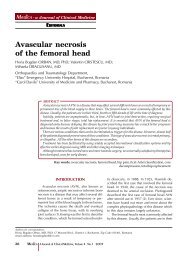Hypereosinophilic Syndromes â Recent Advances In Definition
Hypereosinophilic Syndromes â Recent Advances In Definition
Hypereosinophilic Syndromes â Recent Advances In Definition
You also want an ePaper? Increase the reach of your titles
YUMPU automatically turns print PDFs into web optimized ePapers that Google loves.
M K pag 147M K pag 147HYPEREOSINOPHILIC SYNDROMES – RECENT ADVANCES IN DEFINITION, CLASSIFICATION AND THERAPEUTIC APPROACHThe eosinophil granulocytes are mature leukocytesdifferentiated from CD 34+ myeloidprecursors cells. Production and maturation ofeosinophils take place in the bone marrow andis promoted by cytokines: GM-CSM, IL-3 andespecially IL-5 (a product of CD4+ T-lymphocytes),which appears to be the dominant eosinophilgrowth and survival factor. Thesecytokines are also resposible for the inhibitionof eosinophilic apoptosis (1).Following maturation, eosinophils circulatein blood and migrate to inflammatory sites intissues, or to sites of helminthic infection in responseto certain chemokines (eotaxin-1,eotaxin-2, RANTES), and leukotrienes (leukotrieneB4). At the infectious sites, eosinophilsare activated by Type 2 cytokines released froma specific subset of helper T cells (Th2).Eosinophils are normally found in the bonemarrow, at the junction between the cortex andmedulla of the thymus, in the lower gastrointestinaltract, respiratory structures, ovary, uterus,FIGURE 1. Mature eosinophil and precursors –MGG (40X). (3)FIGURE 2. Mature eosinophil –MGG (100X). (3)spleen, and lymph nodes. The presence of eosinophilsin other organs is associated with disease(2).When examined by standard blood-stainingtechniques, the mature eosinophil is 12-17micrometers in size, with bilobed nucleus andabundant cytoplasm filled with large reddishorange(eosinophilic) granules that do not coverthe nucleus (FIGURES 1 and 2).Eosinophils play an important role in fightinghelminth colonization, viral and fungal infections,they are important mediators of allergy(including asthma pathogenesis). Eosinophilsare also involved in fibrin removal duringinflammation, postpubertal mammary glanddevelopment, oestrus cycling, allograft rejectionand neoplasia. They have also recently beenimplicated in antigen presentation to T cells.Following activation, the eosinophilsdegranulate and release their content: majorbasic protein (MBP), eosinophil cationic protein(ECP), eosinophil peroxidase (EPO), eosinophilderivedneurotoxin (EDN), capable of inducingtissue damage. ECP and EDN are ribonucleaseswith antiviral activity. MBP induces mast cell andbasophile degranulation, and is implicated inperipheral nerve remodeling. ECP creates toxicpores in the membranes of target cells allowingpotential entry of other cytotoxic molecules tothe cell, can inhibit proliferation of T cells, suppressantibody production by B cells, inducedegranulation by mast cells, and stimulate fibroblastcells to secrete mucus. EPO stimulatesreactive oxygen species and promotes oxidativestress causing cell death by apoptosis andnecrosis (4). Other mediators released by eosinophilsare growth factors (such as TGF beta,VEGF, and PDGF), cytokines (such as interleukinand TNF alpha), enzymes (elastase), leukotriensand prostaglandins.<strong>In</strong> normal individuals eosinophils make upabout 1-6% of white blood cells but the absoluteeosinophil count (AEC) seems more correctand is preferred by most authors. The detectionof more than 0.6x109/L eosinophilsdefines eosinophilia.Classification of eosinophilia by its degreemay be the initial clue for diagnosis (TABLE 1, (5)).Classification of eosinophilia (6):1. familial eosinophilia – autosomal dominantdisorder with constant number ofeosinophils and a benign evolutionMædica A Journal of Clinical Medicine, Volume 4 No.2 2009 147






